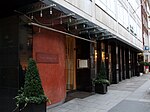Fine Art Society
1876 establishments in the United KingdomArt galleries established in 1876Art museums and galleries in EdinburghArt museums and galleries in LondonGrade II listed buildings in the City of Westminster ... and 2 more
Use British English from August 2015Visual arts exhibitions

The Fine Art Society is a gallery based in both London and in Edinburgh's New Town (originally Bourne Fine Art, established 1978). The New Bond Street, London gallery closed its doors in August 2018 after being occupied by The Fine Art Society since February 1876, the entrance façade of which was designed in 1881 by Edward William Godwin (1833–1886).
Excerpt from the Wikipedia article Fine Art Society (License: CC BY-SA 3.0, Authors, Images).Fine Art Society
New Bond Street, City of Westminster Mayfair
Geographical coordinates (GPS) Address Nearby Places Show on map
Geographical coordinates (GPS)
| Latitude | Longitude |
|---|---|
| N 51.511269 ° | E -0.143822 ° |
Address
New Bond Street 148
W1S 2SE City of Westminster, Mayfair
England, United Kingdom
Open on Google Maps





